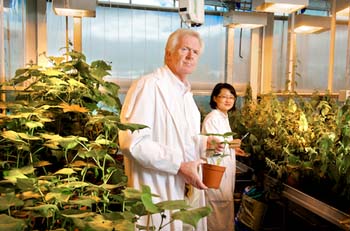Lancaster plant science wins THE research of the year award

The contribution of Lancaster University to one of the biggest challenges facing humankind - feeding seven billion people against a background of climate change - helped it to win the coveted Times Higher Research Project of the Year award held in London on October 15th. The prize went to a Lancaster team of plant biologists, led by Distinguished Professor Bill Davies in the Lancaster Environment Centre , who have identified a chemical signal that roots in drying soil send to the shoots, helping the plant cope with drought.
The fundamental scientific research has identified the phenomenon of root to shoot chemical signalling in plants and identified ways of exploiting this phenomenon, allowing scientists and industry to develop novel irrigation techniques to be used as a component of ‘water saving agriculture’.
Lancaster’s research identified that drying soil can generate chemical signals in plant roots, which are subsequently transported to the shoots to help plants slow water loss and cope with water shortage. These signals are important components of the plant’s armoury against environmental stress, allowing it to optimise growth and water use based on a ‘measure’ of soil water availability contained within the root signal arriving in the shoot and are crucial to the development and survival of plants in water scarce environments.
Over a number of years this research endeavour has shown that these chemical signals can limit the water lost by plants by reducing the aperture of pores on the leaf surface and restrict leaf growth, reducing evaporative water loss from the shoot.
These signals have also been shown to stimulate the production of fruit and seeds. All of these responses can be stimulated by irrigating plants with reduced quantities of water in such a way that signalling is stimulated , also called ‘partial rootzone drying’. Water use is reduced, plants are hardened to drought stress but importantly crop quality and yield are sustained, thereby allowing the production of ‘more crop per drop’.
The University has received around £5 million in competitive funding for this research since 2001. Funding agencies include the UK Research Councils; the EU Framework programmes (III-VII); the UN Atomic Energy Agency/Food & Agriculture Organisation; Industry and Government departments including Defra.
Recent new avenues of research include the use of bacteria which occur naturally in the soil around the roots of some plants to promote plant growth in drying soil. These simple soil additives can be another way to deliver ‘more crop per drop of irrigation water’.
The University has been highly successful in disseminating the results of this fundamental science to user communities. One example has been the development by the University of a range of training programmes with support from schemes such as the Modular Training for Industry (MIT) programme run by the Biotechnology and Biological Sciences Research Council (BBSRC).
Lancaster is applying water saving agriculture in China with collaborators, to focus on an important food production region where water scarcity is a major problem.
There has also been extensive application in viticulture in Australia (in partnership with CSIRO) and in viticulture, fruit and vegetable production around the Mediterranean and in USA.